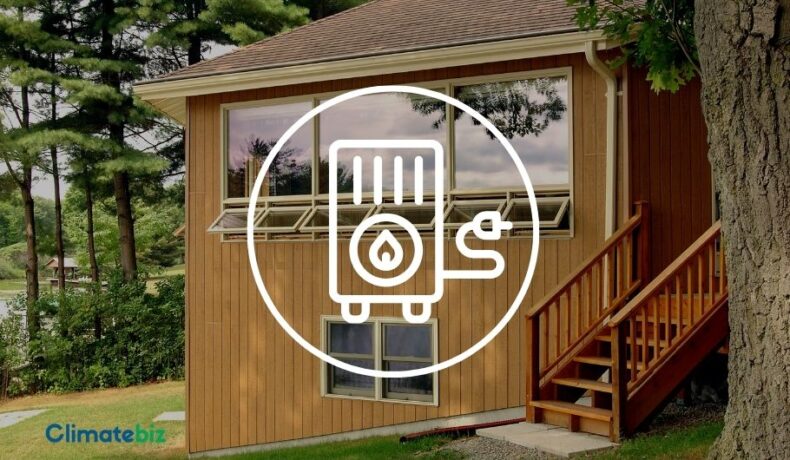The thought of being able to control the thermal comfort of your home with off-grid heating methods seems a bit unreal.
We’ve all become so reliant on electricity nowadays, that the thought of heating our homes without being dependent on electricity seems both amazing and hard to believe.
Well, the good news is that it’s entirely possible!
In this article, we explore ten different off-grid heating methods while answering all of your related questions.
Table of Contents
10 Off-Grid Heating Methods
1. Passive Heating
Passive heating is a design concept that focuses on regulating the internal temperature of your home.
But how? Certain materials and design elements in your home regulate the temperature of the building without the use of heaters or any manual input from you, the homeowner.
Passive heating can in fact include some of the methods below, such as heat pumps or radiant heat. The difference is that passive heating often consists of more than one method.
Specialized windows (passive windows), insulation, thermal mass, and radiant heat allow the home to keep heat in. The flip side of this is that it also allows your home to stay cool in warmer temperatures.
To read more about passive design, you can explore our article on passive cooling, the flip side of passive heating.
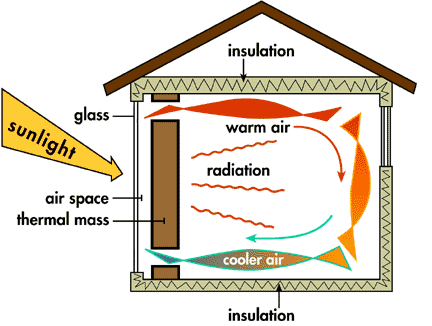
Source: iklimnet
2. Radiant Heat
Heat radiation is when heat transfers from one substance to another through wavelengths. For example, the warmth coming off a fire is radiant. This is because particles from the fire collide with air molecules, creating energy that is then transferred to our skin.
Radiant Heat In Buildings
Think back to a hot day when you couldn’t escape the heat, even inside – that’s thanks to radiant heat. This is when the outdoor climate transfers heat into your home. The heat transfer occurs when the sun and air heat your exterior building elements such as walls or your roof. These elements heat up and either store or transfer the heat inside.
An example of this is when your roof emits heat inwards. As a result, your attic becomes much warmer than the rest of your home.
Household Radiant Heat Sources
The most significant radiant heat sources in your home include heat from the walls, roof, windows, and your body.
Here’s a little fun fact – according to this study from Standford University, 80% of human energy is given off as heat. This is a significant proportion, and a few humans in a small room would heat it quickly.
Despite this, the radiant heat from a human body would not be enough to heat your whole home. Instead, you could include elements such as walls with a high thermal mass. The walls would store solar energy and release it as heat throughout the night.
Ensuring that your home is well insulated would also result in better heat retention in your home. You can read our article on insulation to find out more and how you can use it for off-grid heating.
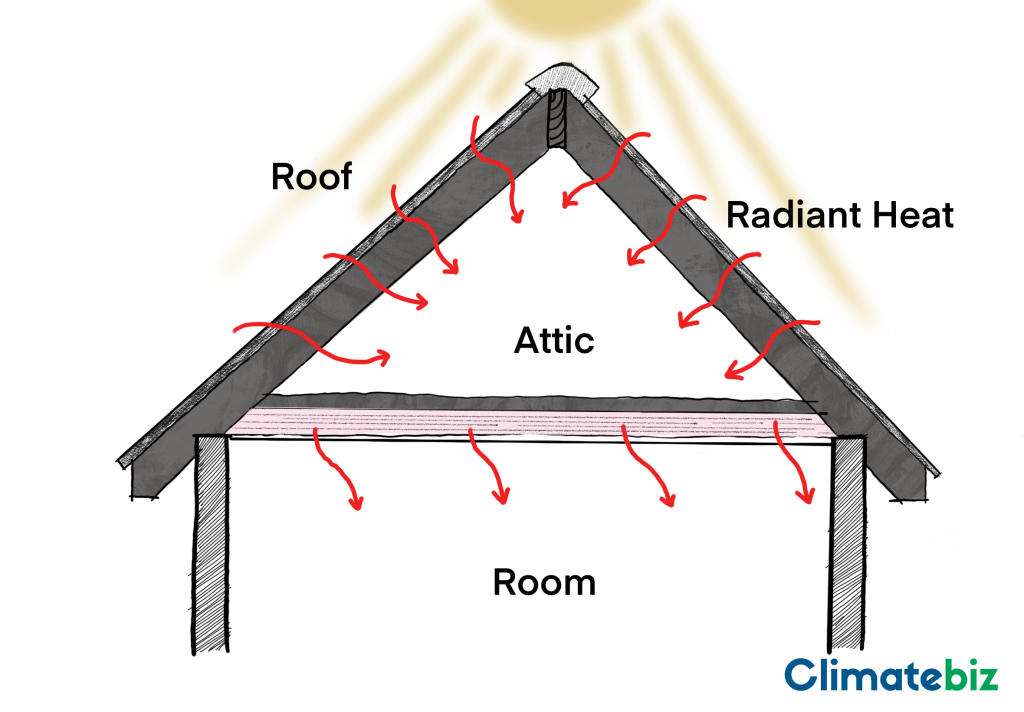
Source: Climatebiz
3. Biomass Boilers
Biomass refers to any organic material that you can use as fuel.
Examples Of Biomass
Organic matter can be collected from your garden, woodlands or bought in the form of wood chips. This makes biomass a cost-effective alternative to other fuel sources like LPG.
Conventional boilers use LPG as a fuel source, burning the fuel and heating the water. Biomass boilers aren’t so different.
They use wood chips, logs, straw, or wheat husk as a fuel source, heating the water you use in your home. In addition, boilers can be used for hot water and central heating.
The Downside
The downside is that this type of boiler often requires a lot of space to store the fuel source. Therefore, it’s advised to keep the biomass nearby always to be ready to use. This means that you’ll need a log pile or storage shed.
Even if you’ve jumped this hurdle, you’ll also have to feed the boiler manually, which can be labor-intensive. Alternatively, you can install an automatic feeder, but that takes up more space and can be expensive to install.
What Really Matters
Although installing a biomass boiler can be a hassle, the benefits are worth it! Biomass boilers have a significantly smaller carbon footprint for the same efficiency as a conventional boiler. In addition, biomass boilers are carbon neutral!* The plants and trees absorb carbon throughout their lifetime. When you use them as a fuel source, they release that carbon back into the atmosphere, becoming carbon neutral.
*It’s important to note that biomass boilers are only carbon neutral if no other carbon is released. The use of motor vehicles to purchase or carry the biomass from one place to another burns carbon. Therefore, more carbon is released than captured.
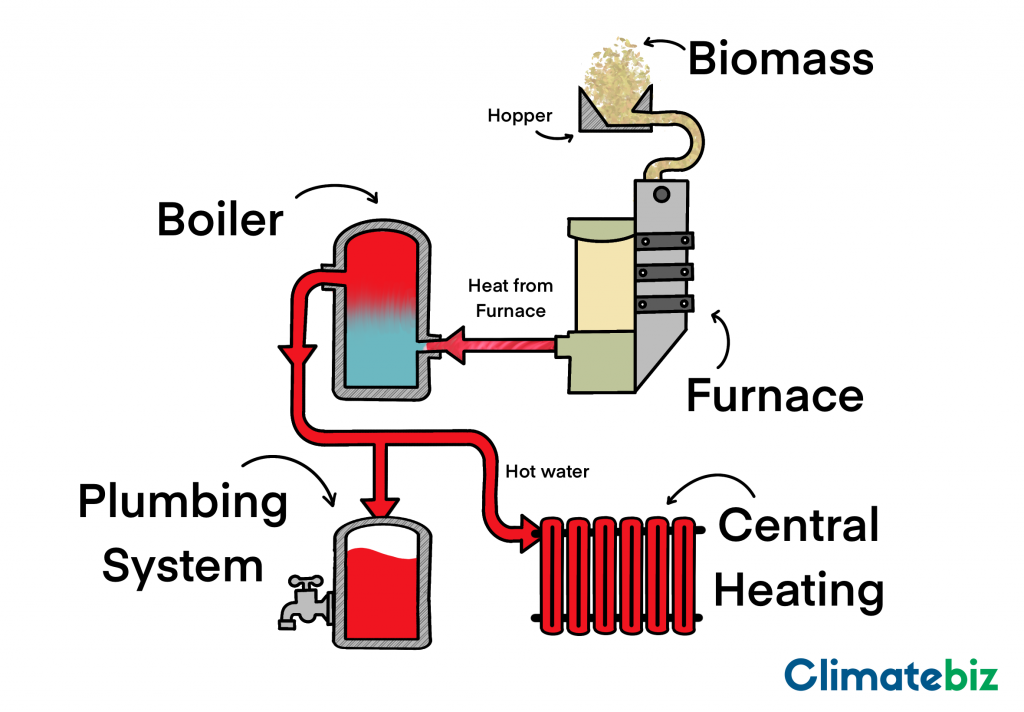
Source: Climatebiz
4. Aerobic Biodegradation of Biomass
We know that energy cannot be created or destroyed, only transferred. Therefore, it makes sense that biomass releases the same energy it captures while growing.
During the biodegradation of biomass, most of the energy creates heat that you can capture.
In a heap of biomass such as wood chips, leaves, or a compost pile, temperatures can reach 70o C. For more information on the bio-degradation process of biomass, you can check out this study.
Water pipes can be laid underneath the heap to capture this heat and use it in your home. While 70o C isn’t boiling, it’s sufficient for household water use.
The only issue is that this temperature depends on the seasons and climate. Colder climates may need a compost heap that’s sheltered. Additionally, in winter, there is not a lot of biomass available. Because of this, your energy source may dwindle quickly and lose efficiency.
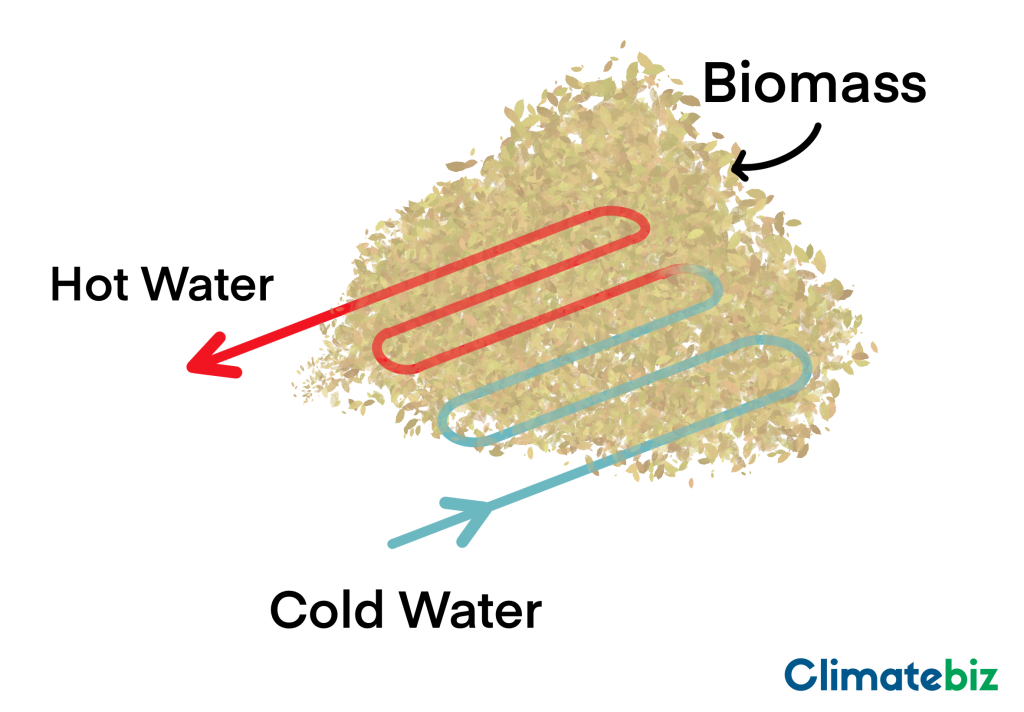
Source: Climatebiz
5. Biogas Boilers
Like biomass boilers, organic matter decomposition and animal waste create biogas.
The biomass and animal waste is placed into a tank, where it decomposes. Gas is released during this process and used as fuel for a boiler.
Below is a diagram that explains just how a biomass boiler works:
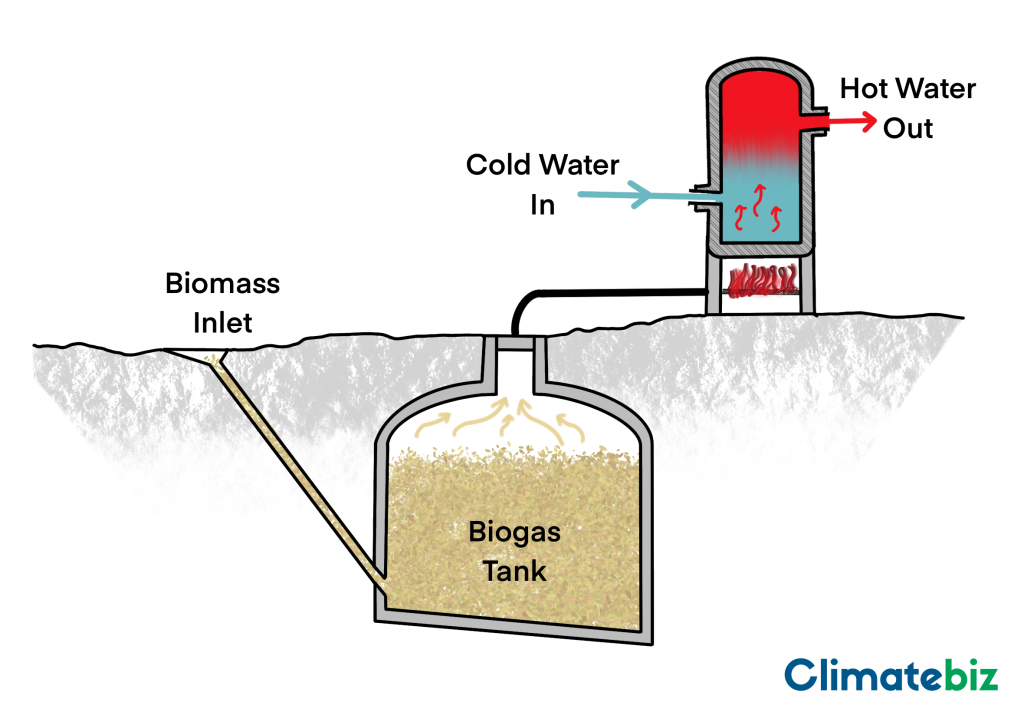
Burning biogas has an efficiency of 80% – 90%. It’s such a reliable heat source that many impoverished countries are dependant on biogas.
It’s also important to note that biogas is used to generate electricity. However, this isn’t exactly a cost-effective heating method for off-grid living. Nevertheless, these systems are often used on a mass scale to power towns.
A biogas boiler is hugely relevant for farms or homes with livestock. You can use animal waste along with the organic waste. Vegetables or crops that aren’t suitable to sell or eat can be tossed into the biogas tank. This decreases your bio-waste and keeps your off-grid home warm.
6. LPG Gas
Liquid petroleum gas, also known as LPG, is a valuable fuel source for off-grid heating.
This gas is widely available and bought in pressurized cylinders. In addition, the infrastructure required is relatively cheap to install and can be used for appliances like heaters or stoves.
How Does It Compare To Other Fuel Sources?
Compared to other fuel sources like diesel and petrol, LPG is cleaner and better for the environment. When suitable stoves and heating systems are combined, LPG will emit 20% – 30% less CO2.
How Much Will You Need?
LPG bottles come in different sizes, measured by the weight of the cylinder. The size of the cylinder you will need depends on the following factors:
- The size of your home.
- The amount of hot water you use.
- Whether you have gas stoves or heaters in your household.
However, the best way to determine how much gas you’ll need is by contacting your nearest LPG outlet.
Pricey
LPG can be expensive, creating a cost boundary for many people. The cost of buying cylinders, transporting them to your home, and then paying to refill them all adds up.
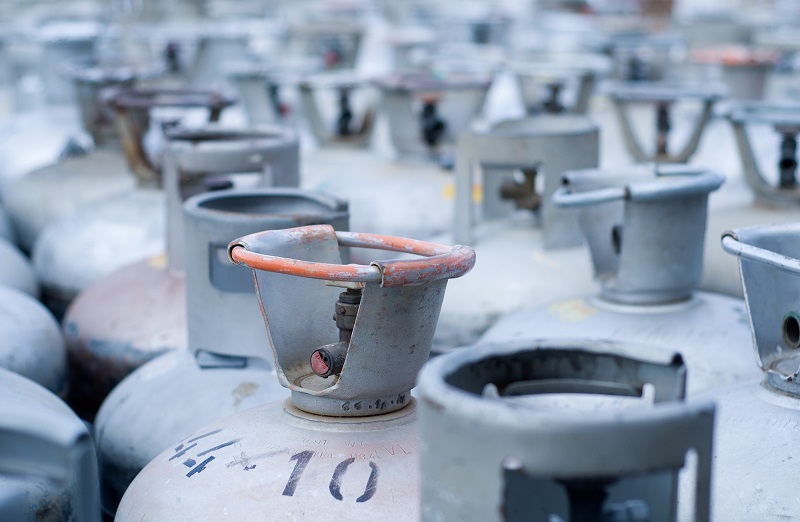
Source: thegasworks
7. Wood Stoves
Wood stoves are the typical way in which people heat their off-grid homes. But did you know that you can also use them to heat your water?
Wood stoves are generally stand-alone stoves that you install in your home. They heat the space around them – some even include a stovetop. When coupled with a heat exchange, wood stoves can heat the room and your water.
Where You Can Install Them
You can install a wood stove into a wall made from masonry or brick. The masonry has an excellent thermal lag, so it’ll store the heat from the fire and slowly release it. You can then easily install a heat exchange device in the wall behind the stove.
Here, the exchange would transfer the heat from the woodstove to water pipes. This water is then pumped into a storage tank, which we can use for hot water.
Overall
Wood stoves are relatively cheap – the only cost is the wood logs you’d require as fuel. And like the biomass boiler, wood stoves are carbon-neutral, making them an excellent option off-grid heating.

Source: bluehost
8. Solar Thermal Panels
Solar power is becoming an affordable option for homeowners these days. With a variety of benefits and decreasing costs, it’s easy to see why.
You can install solar thermal panels onto the roof of your home and use them to heat your household’s water.
The water passes over the panels in thin tubes, allowing solar rays to heat the water as it goes. Depending on your climate, either water or a non-freeze liquid is used.
There are two main types of passive solar heaters:
- A Collector-Storage System
- A Thermosyphon system
Collector-Storage System
Collector-Storage systems take the form of a storage tank made from a transparent material. The solar rays heat the water in the tank, turning the tank into a passive geyser. The water then flows into the plumbing system and is used when necessary.
This system works best for a large household but is subject to cold temperatures and performs best in moderate/warm climates.
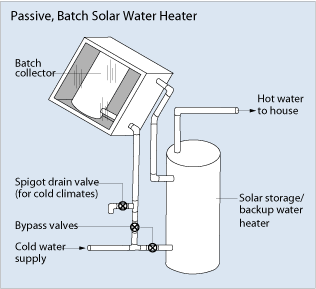
Source: energy.gov
Thermosyphon System
A thermosyphon system takes the classic form of a panel with pipes attached. As explained above, the sun heats the water in the pipes connected to your plumbing system.
When you open your tap, hot water flows out of the system, pulling fresh cold water into it.
This system is best suited for smaller homes, as an average system only holds 40 gallons of water. This means that it can only heat 40 gallons at a time. Additionally, you would need an insulated storage tank for nighttime water usage.

Source: qiruisunny.en.made-in-china
9. Geothermal Heat Pump
Geothermal heat pumps take advantage of the earth’s constant temperatures.
While the climate above ground may change unpredictably, the temperature of the ground rarely changes. In summer, the soil stays cooler than the air outside, and in winter, the opposite occurs.
How They Work
By placing dense, plastic tubes into the ground, geothermal heat pumps use the earth’s warmth to heat your home. An antifreeze solution flows through the pipes, heating up as it flows. It can then be pumped straight into your central heating system or used to heat water through a heat exchange.
There are often two pipes installed alongside each other, placed 5ft underground. The most common layout is that these pipes are run horizontally in loops. This allows for greater efficiency, fitting the greatest length of pipe in the smallest area possible.
The Downside
The downside is that all heat pumps require a certain amount of electricity to run. Therefore, you’d need to couple them with a solar panel – this would increase your system’s cost.
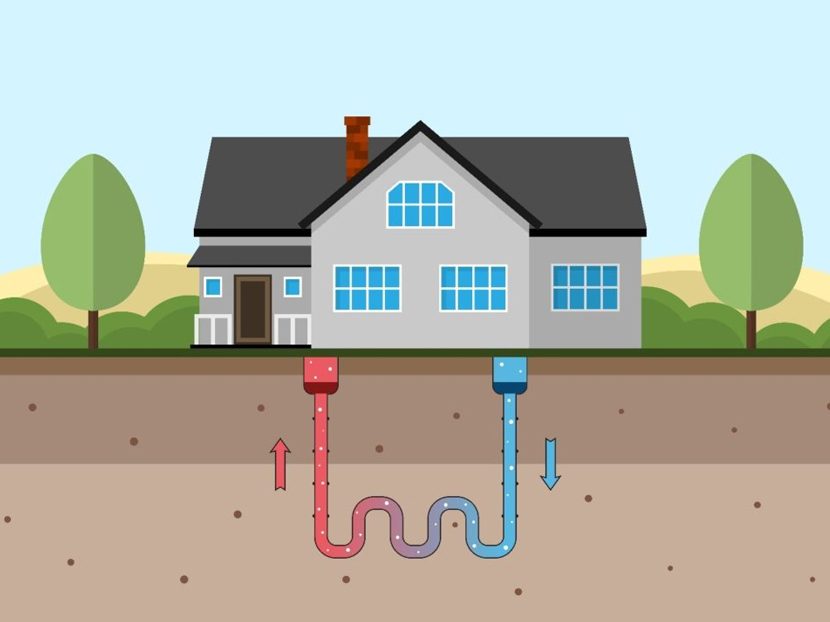
Source: phcppros
10. Airflow Heat Pump
Airflow heat pumps work in a similar fashion to geothermal heat pumps. The system uses the cooler temperatures of the outdoors to warm your home.
The system consists of pipes containing a refrigerant, two coils, and a compressor. One coil is placed outside your home, and the other is used as the heater indoors.
How They Work
Liquid refrigerant in the outside coil absorbs heat from the outdoor climate (yes, even in winter) and becomes vapor. The vapor is then pumped into a compressor, releasing high pressure, heated vapor. This vapor flows through the inside coil, warming up the room. As it does so, it loses heat and condenses into a liquid. It is then pushed back to the outside coil, where it starts again.
There are multiple types of airflow heat pumps, ranging from single area pumps to duct systems.
Again, like the geothermal pump, additional electricity is required for the compressor to operate. However, by linking the system to a solar panel, you’ll be able to keep your home warm efficiently.

Source: remodelingcalculator
Which Off-Grid Heating Method is The Most Efficient?
After exploring all these methods, we’ve seen some very effective ways of warming our homes. In addition, many of the above options are eco-friendly, allowing you to live off-grid comfortably.
But which of the above systems are the most efficient?
Solar panels rank between 70% – 90%. LPG is 90% efficient, whilst biomass boilers are rated at 91% efficiency.
The Winner
However, we can only have one method that can be deemed the most efficient. Heat pumps take the title with a whopping efficiency of 300% – 400%.
Heat Pumps
Even though they need an alternative energy source, heat pumps have the highest efficiency when it comes to off-grid heating.
Due to their reliability and the tiny amount of energy required, they work extremely effectively when it comes to heating and cooling your home.
According to a report by NEEP (Northeast Energy Efficiency Partnerships), heat pumps can save you $459 a year compared to conventional electric heaters.
But which heat pump is more efficient? Geothermal pumps or airflow pumps?
This study shows that airflow pumps are much more efficient when comparing the two, especially when they’re linked to a specialized duct system.
It’s also important to note that your home may have a hybrid heat pump system. For example, certain passive houses use geothermal heat to warm their air ventilation system. By combining geothermal and airflow heat pumps into one system, the home can keep itself warm. Combining these two systems can cut your energy bill by 90%.
Final Thoughts
Whether you’re trying to cut bills or escape into nature, there is an off-grid heating method just for you.
There are many different options you can choose from. While some are more efficient, others are more cost-effective.
We’re excited to see what the future holds for off-grid living and what new technologies could be discovered.
We hope that this article helps you, and we’d love to see what method you use for your project.
And who knows, this may even spark further off-grid-related ideas for you.

